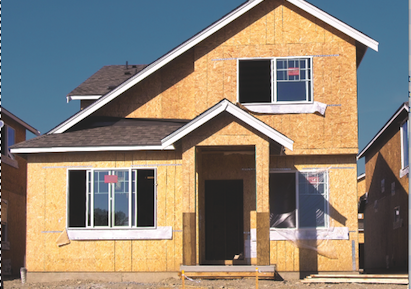The house was a good deal, no question. It was 95-percent finished when David England, president of Exton, Pa.-based Rouse/Chamberlin Homes, bought it from a bankruptcy court.
“I had a buyer for it before I even had the title,” England says.
England made it clear to the buyer that this was not a Rouse/Chamberlin home, and the price reflected that. Because he couldn’t swear to the workmanship behind the walls, he sold the house as-is and provided a third-party warranty.
“We closed on the house on Friday and got a warranty call on Monday,” he says. “The woman put her son in the bathtub on Saturday night, pulled the plug, and water came through the kitchen ceiling.”
The third-party warranty company denied the claim. Despite the conditions of the sale, England took care of the repair. “You can’t be a builder and have a flooded kitchen 48 hours after settlement,” he says.
Such are the risks of finishing a house that another builder started.
It’s an opportunity that many builders find themselves considering as they look at purchasing distressed assets from banks. Along with the finished lots in a subdivision may be a group of spec houses that were started but never finished when the builder ran out of cash. In some parts of the country, such as southwest Florida, buyers canceled deals mid-construction and walked away from their deposits when they realized that they’d be underwater on the mortgage before they even moved in.
Hard numbers on the inventory of these houses are difficult to find. Statistically, the Census Bureau reports that about 2 percent of the houses for which permits are pulled are never completed and considered abandoned. But that number is based on data from 2004, when the housing market was still gathering steam, a Census Bureau spokesperson says. The bureau is working on collecting more-current information but has yet to publish it. Anecdotally, they know that percentage today is significantly higher.
There is enough inventory, though, for panels of experts to be put together to make presentations at conferences, and for companies such as La Jolla Pacific to start offering services to assess the condition of distressed properties and the cost to complete them.
‘Fraught with risk’
With the right price and the right location, the numbers on any house can look like a great deal. The key to making money on these houses is thorough due diligence and an incredibly clear understanding of the liability issues. Even some savvy builders aren’t thinking through all the concerns, says Mark Himmelstein, a partner with the Newport Beach, Calif.-based law firm Newmeyer & Dillion, who has more than 25 years of construction litigation experience.
“We have very sophisticated business people who will show you a pro forma about picking up these projects, selling them, and walking away with all these profits,” Himmelstein says. “We tell them, ‘You have an obligation under California’s fix-it law of at least a year. Who will do that? You have liability for construction defect. How do you insure for that?’ Some people haven’t considered these at all. If they have, they’ll say they talked to their broker and they have a policy that does them no good at all.”
Carlsbad, Calif.-based Barratt Group has been buying and finishing properties, including the Villas at Montecito, a townhouse community in South Atascadero, Calif. “You have to know what you’re getting in to,” says CEO Mick Pattinson. “Be prepared to do remedial work. In some cases, it may involve tearing it down all together.”
His company looks for projects that are either in the early stages of construction or nearly finished. “The biggest risk is a house that’s framed and has sat out in the elements for a year or two,” says Pattinson.
Then there are the risks related to the deal itself. In their due diligence of various properties, principals at Barratt Group uncovered such issues as problems with liens at a project that was in receivership.
“They got the liens cleared on the houses, but they forgot about the common areas,” says Barratt Group principal and general counsel J. Michael Armstrong. “On another one of our old sites, Bank of America foreclosed the airspace, but not the underlying land. This is typically what happens with these bank foreclosures.”
Then, of course, there is the liability that goes with selling the houses.
“If a builder owns the unfinished house, finishes it and sells it, that’s got some hair on it,” says Jeffrey Masters, litigation partner with the law firm Cox Castle Nicholson LLP, Los Angeles. “The builder most likely will be liable for the completed home. State law varies, but that’s a pretty safe assumption. It is fraught with risk.”
If you think you can cover yourself by selling the house as-is, think again.
“Builders need to understand that the as-is disclaimer is not going to give them all the protection they think it might,” says Terry Cooke, general counsel for Chantilly, Va.-based Professional Warranty Service Corp., a warranty service provider for home builders. “Courts that have looked at this question are very skeptical of the as-is disclaimer, especially on a house that hasn’t been occupied. Some states require the seller of a new home to stand behind the work for a number of years and won’t allow an as-is disclaimer.”
The best approach from a liability perspective, Cooke says, is to look at the house as if you built it from the ground up.
“If you’re on the chain of title, you have all the liability,” he says. “You need to look at it as if you’re starting from day one, managing your warranty risk exposure accordingly. The homeowner will always look to the person who sold them the property to make it right.”
Inspecting the property
The confidence you have in the construction will vary widely. Many of the unfinished houses available today were started by reputable companies with solid construction practices. If it was a one-off builder with little or no track record, there’s no telling what’s behind the walls. That’s why a thorough inspection of the property is a critical step in deciding whether to take on an unfinished house.
Don Neff is president and CEO of Irvine, Calif.-based La Jolla Pacific, a construction quality assurance consulting firm for builders, insurance companies, general contractors, and lenders. Among the company’s services is distressed asset review. He’s seen plenty of projects that met all the industry quality standards.
“We see that most projects are well built,” Neff says. “The builder just got caught in the wrong part of the cycle. It’s a simple matter for a sophisticated builder who knows his business to come in, finish them out, and offer them to buyers or renters.” Then there was the project in Riverside, Calif.
“It was clear to us the original builder didn’t know what they were doing,” Neff says. “There was work done out of sequence just to show progress to get the next draw. They were using window installation systems and assemblies that were 15 years out of date. It was so far below the industry standard that you’d want to rip them out and start again. That project was a disaster.”
Of course, the physical inspection of the property needs to include a detailed analysis of cost to complete. Generally, the age of the house and the exposure to the elements are the most important considerations for a risk assessment, Neff says.
“There are certain useful lives for some building materials, weatherproofing wrap, for example,” he says. “The extent that the sticks and bricks of the building, the wood-framing members, have been protected is important. At a minimum, you’d want the building protected or dried in. If it’s not and it’s been sitting there for 18 to 24 months, you probably have studs that are warped, bowed, or weathered. It will take a higher level of retrofit to bring it back to useable condition.”
Generally, housewrap and roof paper only have an unprotected lifespan of 30 to 120 days, says Mark Williams, FAIA, president of Williams Building Diagnostics in Bradenton, Fla. Peel-and-stick flashing is supposed to be covered within 30 to 90 days. After that, it’s susceptible to UV degradation.
Even if a house is to the drywall stage, there can be issues from lack of use.
“Houses are meant to be started, finished, and lived in,” says Williams. “If the mechanicals are in but they’re not being operated, you can have problems.”
In some cases, it may make more sense to demolish what’s been done to date and start over at the foundation.
“When you go through and do the numbers, it’s amazing how little the shell is worth,” England says. “One house we’re looking at is all framed and ready to go. The shell isn’t worth saving.”
What about insurance?
If this kind of opportunity had been available during the housing boom, liability insurance brokers would have laughed builders out the door. That was then; this is now. One of the results of the downturn is that the insurance market is the softest it has been in years. Not only is coverage for a prior builder’s work available, it should be affordable.
“A few years ago, I wouldn’t have taken one of these on a bet,” says Robert Gore, executive vice president of New York City-based Willis Construction Group, a leading provider of construction insurance. “In an effort to write more business, underwriters are a lot more flexible in their thinking than they used to be. You can get coverage for whatever liability you inherited, coverage for all your own work going forward, and get it at a cut-rate price because you don’t know if you can sell them. It’s kind of the nature of the business. We do deals like this several times a week.”
What’s important for builders to know, however, is the coverage isn’t part of a standard policy.
“General liability policies don’t contemplate this eventuality,” says Gore. “No one thought of this when they were writing the policy. The language doesn’t apply.”
However, the changes that need to be made to the policy are “pretty simple,” he says. In his policies, Gore redefines completed operations to encompass “the project” instead of being limited to “your work” or limit coverage for past work to only apply to the new owner’s interest.
There’s money to be made
The bottom line is that with the right approach, there’s money to be made completing unfinished houses. Fortunately, most of the unfinished houses were constructed by reputable builders.
“There can be a happy ending,” Himmelstein says. “It’s not like we have a lot of crappy construction out there. If it’s been properly protected, hopefully it can be a good project. Quite often what we’re seeing now is small phases where builders are coming in and completing a project that will have a relatively small cost to complete. They’re obtaining insurance and selling them to homeowners.”
To be successful, you need to do your homework and be prepared for the unexpected.
“Check everything down to the risers on the stairs,” England says. “If you don’t check everything, it will be the one thing that goes wrong. They’re a great opportunity, but there will always be unexpected things that will surprise you. You have to buy them at the right price — and have enough money to cover the mistakes.”
Thinking about buying unfinished houses? Don’t skip these steps.
If you’re considering completing unfinished houses or unfinished neighborhoods, here are six steps you should take to protect yourself, courtesy of Jeffrey D. Masters, litigation partner and co-chair of the Development Risk Management Practice Group at the law firm Cox Castle & Nicholson, LLP in Los Angeles:
- Do your due diligence so you know exactly what you are acquiring. This should include: A. Title review. For example, was there a foreclosure and did the foreclosure wipe out prior mechanics’ liens?; B. Physical review. You need to do a thorough quality assurance inspection to determine the quality of the prior work and the extent and cost of any needed corrections. This is especially important if the homes have been exposed to the elements for an extended period of time or if there have been code changes since the house was started. To assure objectivity, Masters recommends using an independent, third-party company to do the inspections. C. Documentation review. You need to know if all the necessary entitlements and permits are in place and still valid. Are there tract map conditions that need to be satisfied? For example, if the original development agreement called for building a school or a fire station, are you obligated to honor that? Are there boundary conditions or easements you need to know about?
- Perform QA inspections during construction as a double check on the trades’ quality of work.
- Obtain appropriate liability insurance, providing coverage for both new work you perform and for prior work performed by others. Standard, off-the-shelf insurance policies almost certainly will not provide the kind of coverage you need, Masters says.
- Provide full disclosure to prospective buyers. Market and sell the property as-is, where permitted by state law. Offering a third-party warranty is a good sales strategy.
- If you’re not selling the house as-is, you need effective long-term customer service and warranty operations, with appropriate staffing and reserves. A major cause of construction defect litigation is real or perceived failures of customer service.
- Use protective provisions in consumer sales documents, including broad disclosures and alternative dispute resolution (ADR) provisions, such as binding arbitration of disputes. Check state law to see if notice and opportunity to repair statutes apply, which may give you important inspection and repair rights in a construction defect dispute.
Advertisement
Related Stories
Housing Giants
The 2024 Housing Giants Survey Is Now Open!
Complete the 2024 Housing Giants Survey to see if your company makes the cut in Pro Builder's rankings of the largest home building companies in the country
Business Management
Meet the Young Leaders in Pro Builder's 2023 Forty Under 40
Recognizing and celebrating our 2023 Forty Under 40 class of energetic, innovative young leaders representing the future of the housing industry
Business Management
WOTUS Rulings Cause Confusion for Home Builders
NAHB Housing Policy Briefing: Lack of clarity for land developers and builders regarding waters of the United States; construction labor market update







